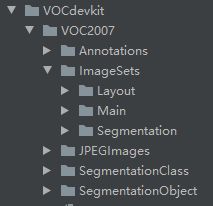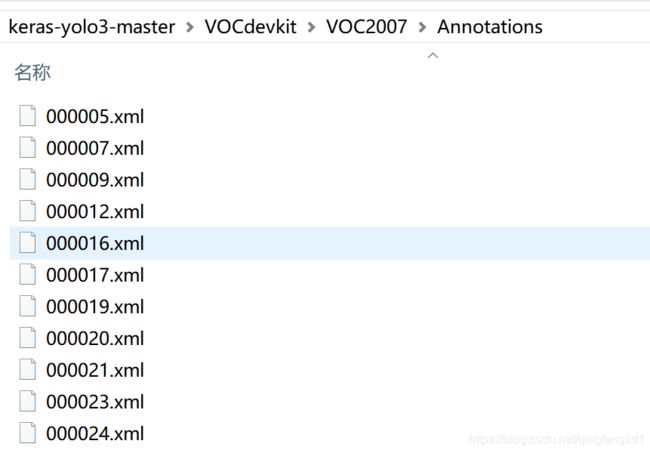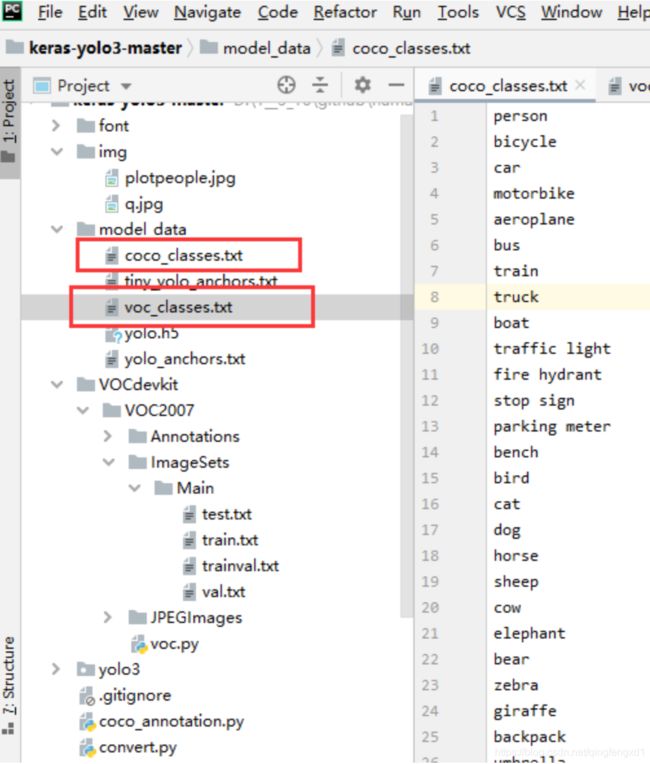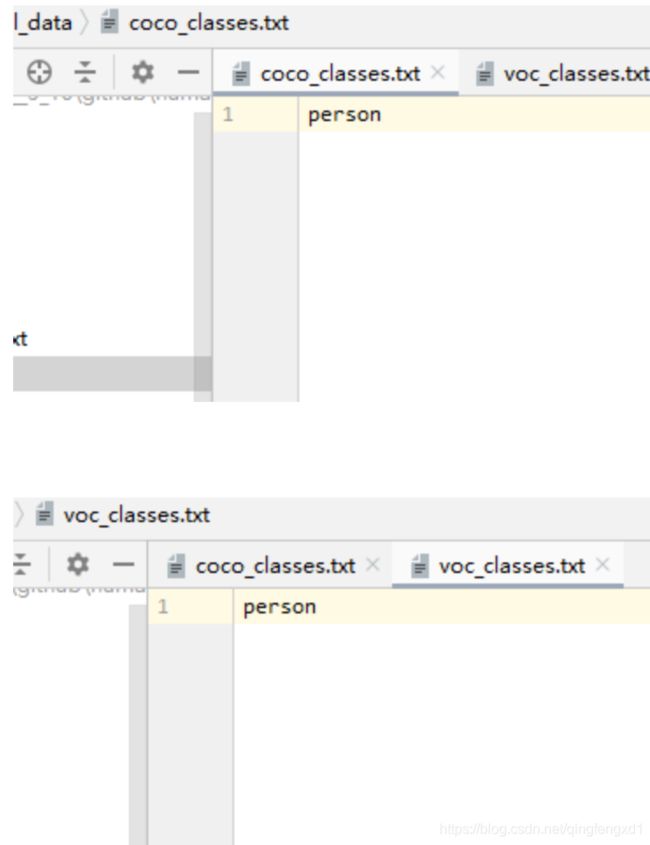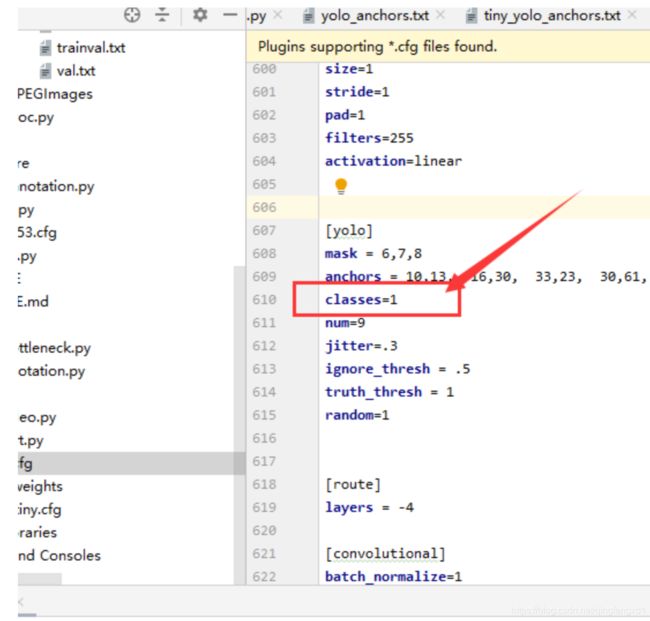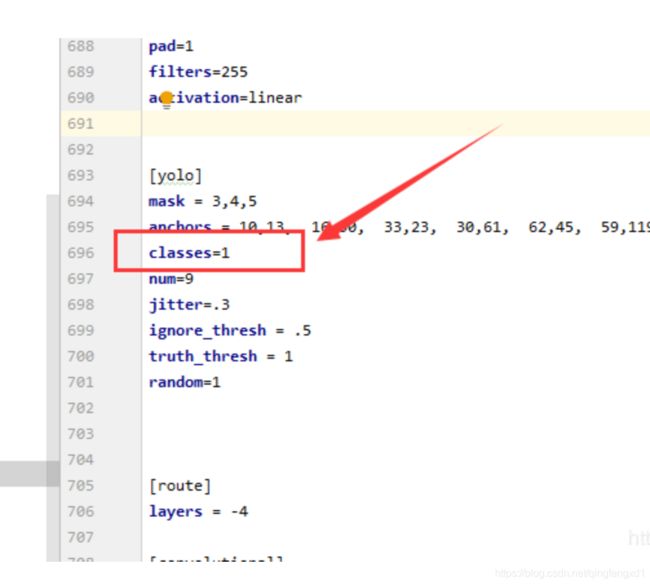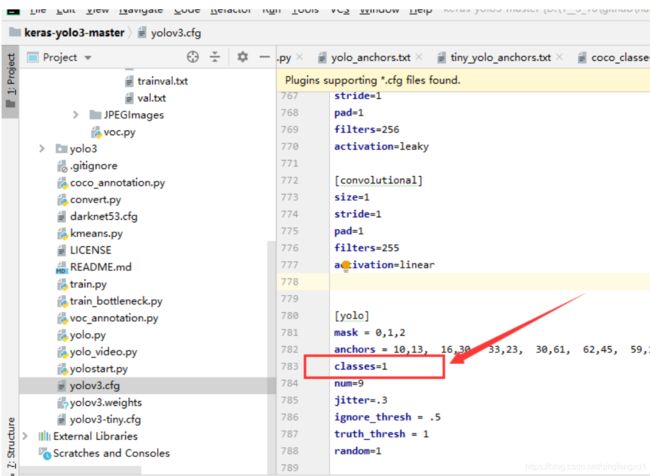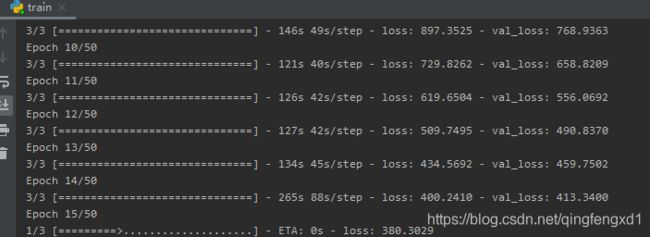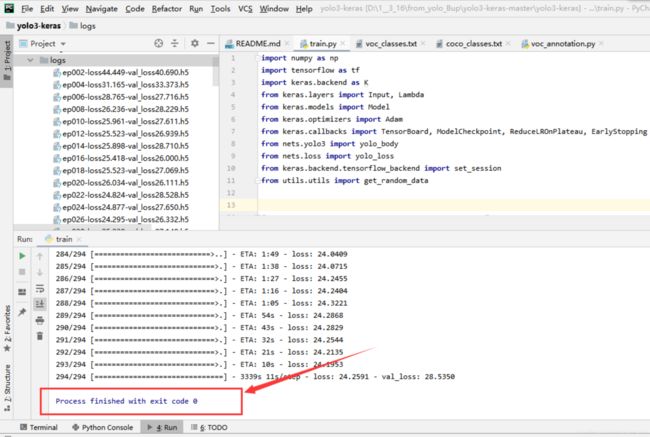个人笔记本上win10+yolov3+python+tensorflow+keras训练自己的识别模型
本文是在前人的很多基础上自己整理所得,借鉴的资料见文末链接,感谢各位大神的无私分享。
对于yolo小白,参阅博文学习:keras-yolov3目标检测详解——适合新手, (环境配置、用官方权重识别自己的图片)
前提准备:
1、配置好环境的 python、pycharm
2、labelimg 软件:下载方法: labelme
3、准备一些图片,创建训练需要的 VOC 文件
(1) 官方的VOC2007下载链接:http://host.robots.ox.ac.uk/pascal/VOC/voc2007/VOCtrainval_06-Nov-2007.tar,可以从这里找需要的图片,或者一些有基础的朋友可以写爬虫去爬一些图片
(2) voc2007百度网盘下载链接:
链接:https://pan.baidu.com/s/18wqRTZDSz5NQEtvq0u0a1g
提取码:hexy
正式训练步骤:
1、打开文件夹
先按照这篇文章的步骤操作:keras-yolov3目标检测详解——适合新手
完成后打开的文件夹应该是这样的:
2、新建voc2007数据集(存放自己的图片及标注信息)
新建的文件夹:如下
![]()
ImageSets 文件夹下还有个名为 Main 的小文件夹
文件结构
VOCdevkit{
VOC2007{ Annotations
ImageSets{main}
JPEGImages }
}
虽然表达的很丑,但是上面有图,应该还是可以看明白的
注意:文件夹的名称必须和上面展示的一样,这是 yolo 默认的
不然还需要改代码才行
3、用labelimg软件对自己的图片进行信息标注
----labelimg 的使用方法:labelimg 下载和标注 xlm 文件
(1)需要训练的图片放在 JPEGImages 里面: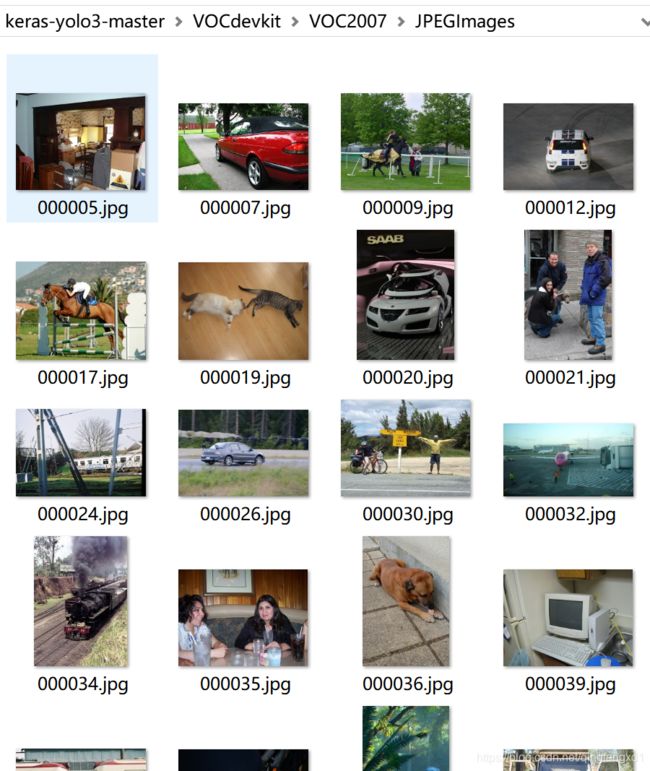
(2)labelimg 标注的 xml 文件放在 Annotations 里面:
4、在 VOC2007 里新建一个 py 文件,取名 voc.py
import os
import random
trainval_percent = 0.2 #测试集占0.2
train_percent = 0.8 #训练集占0.8
xmlfilepath = 'Annotations'
txtsavepath = 'ImageSets\Main'
total_xml = os.listdir(xmlfilepath)
num = len(total_xml)
list = range(num)
tv = int(num * trainval_percent)
tr = int(tv * train_percent)
trainval = random.sample(list, tv)
train = random.sample(trainval, tr)
ftrainval = open('ImageSets/Main/trainval.txt', 'w')
ftest = open('ImageSets/Main/test.txt', 'w')
ftrain = open('ImageSets/Main/train.txt', 'w')
fval = open('ImageSets/Main/val.txt', 'w')
for i in list:
name = total_xml[i][:-4] + '\n'
if i in trainval:
ftrainval.write(name)
if i in train:
ftest.write(name)
else:
fval.write(name)
else:
ftrain.write(name)
ftrainval.close()
ftrain.close()
fval.close()
ftest.close()
然后运行 voc.py 文件,运行成功的话 mian 文件夹里会多了四个 txt 文件
二、进行训练前的最后准备
1、修改 voc_annotation.py 文件并运行
更改这里的 classes 的数量,你voc2007里标注了哪几种,你就留哪几种就行
比如我的 voc 中只标注了 “person”,那我只留下“person”,然后再运行一下就行
运行完成后会多出这几个 txt 文件![]()
2、修改 model_data
将 coco_classes.txt 和 voc_classes.txt 中也只留下VOC2007 中所标注的那个类型
比如我标注的只有 “person”。那我只留下“person”
3、修改 yolo3.cfg
大概在 610、696 和 783 行的位置,把 classes 的数值都改为 1
注:IDE里直接打开cfg文件,ctrl+f搜 yolo, 总共会搜出3个含有yolo的地方,睁开你的卡姿兰大眼睛,3个yolo!!
每个地方都要改3处,filters:3*(5+len(classes));
classes: len(classes) = 3,这里以红、黄、蓝三个颜色为例
![]()
4、添加官方权重
按照上篇博文步骤进行的朋友应该下载好了 yolov3.weights 文件并转为了 yolo.h5 文件
附上上篇博文的链接(里面有下载链接和转化方法):keras-yolov3目标检测详解——适合新手
将 yolo.h5 改名为 yolo_weights.h5
5、新建 logs 文件夹存放训练的 权重文件
6、开始训练
有官方版本,有些大神说官方版本出错,自己写了训练脚本,我用的官方的,没出问题,整体的原理一样,主要是第三方库的问题。
"""
Retrain the YOLO model for your own dataset.
"""
import numpy as np
# import keras.backend as K
from tensorflow.compat.v1.keras import backend as K
from keras.layers import Input, Lambda
from keras.models import Model
from keras.optimizers import Adam
from keras.callbacks import TensorBoard, ModelCheckpoint, ReduceLROnPlateau, EarlyStopping
from yolo3.model import preprocess_true_boxes, yolo_body, tiny_yolo_body, yolo_loss
from yolo3.utils import get_random_data
def _main():
annotation_path = 'train.txt'
log_dir = 'logs/'
classes_path = 'model_data/voc_classes.txt'
anchors_path = 'model_data/yolo_anchors.txt'
class_names = get_classes(classes_path)
num_classes = len(class_names)
anchors = get_anchors(anchors_path)
input_shape = (416, 416) # multiple of 32, hw
is_tiny_version = len(anchors) == 6 # default setting
if is_tiny_version:
model = create_tiny_model(input_shape, anchors, num_classes,
freeze_body=2, weights_path='model_data/tiny_yolo_weights.h5')
else:
model = create_model(input_shape, anchors, num_classes,
freeze_body=2, weights_path='model_data/yolo_weights.h5') # make sure you know what you freeze
logging = TensorBoard(log_dir=log_dir)
checkpoint = ModelCheckpoint(log_dir + 'ep{epoch:03d}-loss{loss:.3f}-val_loss{val_loss:.3f}.h5',
monitor='val_loss', save_weights_only=True, save_best_only=True, period=3)
reduce_lr = ReduceLROnPlateau(monitor='val_loss', factor=0.1, patience=3, verbose=1)
early_stopping = EarlyStopping(monitor='val_loss', min_delta=0, patience=10, verbose=1)
val_split = 0.1
with open(annotation_path) as f:
lines = f.readlines()
np.random.seed(10101)
np.random.shuffle(lines)
np.random.seed(None)
num_val = int(len(lines)*val_split)
num_train = len(lines) - num_val
# Train with frozen layers first, to get a stable loss.
# Adjust num epochs to your dataset. This step is enough to obtain a not bad model.
if True:
model.compile(optimizer=Adam(lr=1e-3), loss={
# use custom yolo_loss Lambda layer.
'yolo_loss': lambda y_true, y_pred: y_pred})
batch_size = 32
print('Train on {} samples, val on {} samples, with batch size {}.'.format(num_train, num_val, batch_size))
model.fit_generator(data_generator_wrapper(lines[:num_train], batch_size, input_shape, anchors, num_classes),
steps_per_epoch=max(1, num_train//batch_size),
validation_data=data_generator_wrapper(lines[num_train:], batch_size, input_shape, anchors, num_classes),
validation_steps=max(1, num_val//batch_size),
epochs=50,
initial_epoch=0,
callbacks=[logging, checkpoint])
model.save_weights(log_dir + 'trained_weights_stage_1.h5')
# Unfreeze and continue training, to fine-tune.
# Train longer if the result is not good.
if True:
for i in range(len(model.layers)):
model.layers[i].trainable = True
model.compile(optimizer=Adam(lr=1e-4), loss={'yolo_loss': lambda y_true, y_pred: y_pred}) # recompile to apply the change
print('Unfreeze all of the layers.')
batch_size = 32 # note that more GPU memory is required after unfreezing the body
print('Train on {} samples, val on {} samples, with batch size {}.'.format(num_train, num_val, batch_size))
model.fit_generator(data_generator_wrapper(lines[:num_train], batch_size, input_shape, anchors, num_classes),
steps_per_epoch=max(1, num_train//batch_size),
validation_data=data_generator_wrapper(lines[num_train:], batch_size, input_shape, anchors, num_classes),
validation_steps=max(1, num_val//batch_size),
epochs=100,
initial_epoch=50,
callbacks=[logging, checkpoint, reduce_lr, early_stopping])
model.save_weights(log_dir + 'trained_weights_final.h5')
# Further training if needed.
def get_classes(classes_path):
'''loads the classes'''
with open(classes_path) as f:
class_names = f.readlines()
class_names = [c.strip() for c in class_names]
return class_names
def get_anchors(anchors_path):
'''loads the anchors from a file'''
with open(anchors_path) as f:
anchors = f.readline()
anchors = [float(x) for x in anchors.split(',')]
return np.array(anchors).reshape(-1, 2)
def create_model(input_shape, anchors, num_classes, load_pretrained=True, freeze_body=2,
weights_path='model_data/yolo_weights.h5'):
'''create the training model'''
K.clear_session() # get a new session
image_input = Input(shape=(None, None, 3))
h, w = input_shape
num_anchors = len(anchors)
y_true = [Input(shape=(h//{0:32, 1:16, 2:8}[l], w//{0:32, 1:16, 2:8}[l], \
num_anchors//3, num_classes+5)) for l in range(3)]
model_body = yolo_body(image_input, num_anchors//3, num_classes)
print('Create YOLOv3 model with {} anchors and {} classes.'.format(num_anchors, num_classes))
if load_pretrained:
model_body.load_weights(weights_path, by_name=True, skip_mismatch=True)
print('Load weights {}.'.format(weights_path))
if freeze_body in [1, 2]:
# Freeze darknet53 body or freeze all but 3 output layers.
num = (185, len(model_body.layers)-3)[freeze_body-1]
for i in range(num): model_body.layers[i].trainable = False
print('Freeze the first {} layers of total {} layers.'.format(num, len(model_body.layers)))
model_loss = Lambda(yolo_loss, output_shape=(1,), name='yolo_loss',
arguments={'anchors': anchors, 'num_classes': num_classes, 'ignore_thresh': 0.5})(
[*model_body.output, *y_true])
model = Model([model_body.input, *y_true], model_loss)
return model
def create_tiny_model(input_shape, anchors, num_classes, load_pretrained=True, freeze_body=2,
weights_path='model_data/tiny_yolo_weights.h5'):
'''create the training model, for Tiny YOLOv3'''
K.clear_session() # get a new session
image_input = Input(shape=(None, None, 3))
h, w = input_shape
num_anchors = len(anchors)
y_true = [Input(shape=(h//{0:32, 1:16}[l], w//{0:32, 1:16}[l], \
num_anchors//2, num_classes+5)) for l in range(2)]
model_body = tiny_yolo_body(image_input, num_anchors//2, num_classes)
print('Create Tiny YOLOv3 model with {} anchors and {} classes.'.format(num_anchors, num_classes))
if load_pretrained:
model_body.load_weights(weights_path, by_name=True, skip_mismatch=True)
print('Load weights {}.'.format(weights_path))
if freeze_body in [1, 2]:
# Freeze the darknet body or freeze all but 2 output layers.
num = (20, len(model_body.layers)-2)[freeze_body-1]
for i in range(num): model_body.layers[i].trainable = False
print('Freeze the first {} layers of total {} layers.'.format(num, len(model_body.layers)))
model_loss = Lambda(yolo_loss, output_shape=(1,), name='yolo_loss',
arguments={'anchors': anchors, 'num_classes': num_classes, 'ignore_thresh': 0.7})(
[*model_body.output, *y_true])
model = Model([model_body.input, *y_true], model_loss)
return model
def data_generator(annotation_lines, batch_size, input_shape, anchors, num_classes):
'''data generator for fit_generator'''
n = len(annotation_lines)
i = 0
while True:
image_data = []
box_data = []
for b in range(batch_size):
if i == 0:
np.random.shuffle(annotation_lines)
image, box = get_random_data(annotation_lines[i], input_shape, random=True)
image_data.append(image)
box_data.append(box)
i = (i+1) % n
image_data = np.array(image_data)
box_data = np.array(box_data)
y_true = preprocess_true_boxes(box_data, input_shape, anchors, num_classes)
yield [image_data, *y_true], np.zeros(batch_size)
def data_generator_wrapper(annotation_lines, batch_size, input_shape, anchors, num_classes):
n = len(annotation_lines)
if n == 0 or batch_size <= 0:
return None
return data_generator(annotation_lines, batch_size, input_shape, anchors, num_classes)
if __name__ == '__main__':
_main()
成功开始训练,训练时间比较长,需要耐心等待
训练完成:
我的结果还没跑完,下面结果看看就行
训练好的权重都放在 logs 文件夹下的 000 文件夹里:
按理说训练会经过两个阶段,且自动从一堆 loss 中选则出 loss最低的文件(应该是 earlystop函数的作用):
应该就是下面的框选的这两个 h5文件,都可以使用![]()
使用的方法就和前面那篇博文操作一样了(用这个h5权重模型去识别自己图片),
参考资料:
1、https://blog.csdn.net/qq_45504119/article/details/105052478 重点
2、https://blog.csdn.net/Patrick_Lxc/article/details/80615433
3、https://blog.csdn.net/m0_37857151/article/details/81330699
4、https://blog.csdn.net/mingqi1996/article/details/83343289
5、https://blog.csdn.net/davidlee8086/article/details/79693079
6、https://blog.csdn.net/u012746060/article/details/81183006
7、https://blog.csdn.net/weixin_45488478/article/details/98397947
8、https://blog.csdn.net/sinat_26917383/article/details/85614247?utm_medium=distribute.pc_relevant.none-task-blog-BlogCommendFromMachineLearnPai2-1.nonecase&depth_1-utm_source=distribute.pc_relevant.none-task-blog-BlogCommendFromMachineLearnPai2-1.nonecase
9、

